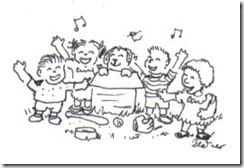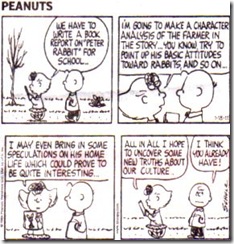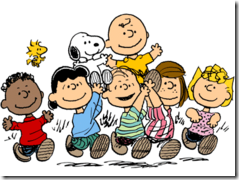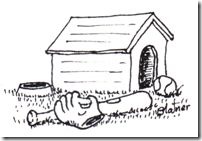Adam Blatner
Words and Images from the Mind of Adam Blatner
Peter Rabbit: A Critical Analysis
Originally posted on January 19, 2011
[Explanation: In October, 2009, played the role of “Linus” in a community production of the late 1960s Broadway Musical “You’re a Good Man, Charlie Brown,” based on  Charles Schulz’ comic strip, “Peanuts.” I played the part of a rather precocious intellectual child who at the same time was caught up in an infatuation with my security blanket—and I was reassured that my beard did not interfere with the effectiveness of this portrayal. (My cartoon of the “gang” on the right.)
Charles Schulz’ comic strip, “Peanuts.” I played the part of a rather precocious intellectual child who at the same time was caught up in an infatuation with my security blanket—and I was reassured that my beard did not interfere with the effectiveness of this portrayal. (My cartoon of the “gang” on the right.)
In one part, we had to make a book report on the Beatrix Potter classic children’s story of Peter Rabbit , and the playwright used this device to show how the other main characters would tackle this assignment. (Was this  bit based on the strip on the left?) Charlie Brown dithered; Schroeder took off on his own review of the exciting movie, Robin Hood, comparing it weakly to the assigned book; Linus’ big sister, the narcissistic and fiercely manipulative Lucy, well, manipulated.
bit based on the strip on the left?) Charlie Brown dithered; Schroeder took off on his own review of the exciting movie, Robin Hood, comparing it weakly to the assigned book; Linus’ big sister, the narcissistic and fiercely manipulative Lucy, well, manipulated.
Linus in his own way analyzed the book thus:
“In examining a work such as Peter Rabbit, it is important that the superficial characteristics of its deceptively simple plot should not be allowed to blind the reader to the more substantial fabric of its deeper motivation.
In this report I plan to discuss the sociological implications of family pressures so great as to drive an otherwise moral rabbit to perform acts of theivery, which he consciously knew were against the law.
I also hope to explore the personality of Mister Macgregor, in his conflicting roles as farmer and humanitarian. Peter Rabbit is established from the start as a benevolent hero, and it is only with the increase of social pressures that the seams of his moral fabric begin to unravel . . .(and later) . . . Not to mention the extreme pressure exerted on him by his deeply rooted rivalry with Flopsy, Mopsy and Cottontail!”
So I learned this part and rehearsed it. But I couldn’t help but carrying on Linus / Adam’s game and so I did! I did analyze the book, thus:
 In examining a work such as the late-1960s Broadway Musical Play, You’re a Good Man, Charlie Brown (based on the then-and-continuing popularity of the newspaper comic strip Peanuts, drawn and created by the late Charles Schulz), it is important that the superficial characteristics of the deceptively simple sub-plots in this play should not be allowed to blind the audience to the more substantial fabric of its deeper implications.
In examining a work such as the late-1960s Broadway Musical Play, You’re a Good Man, Charlie Brown (based on the then-and-continuing popularity of the newspaper comic strip Peanuts, drawn and created by the late Charles Schulz), it is important that the superficial characteristics of the deceptively simple sub-plots in this play should not be allowed to blind the audience to the more substantial fabric of its deeper implications.
In this report I plan to discuss the psycho-spiritual implications relating to a story of a fictional character, Charlie Brown, who experiences a mixture of social and spiritual pressures so great as to lead an otherwise intuitively positive boy to commit acts of subservience and self-doubt that he subconsciously sensed were at variance with his deeper worldview.
I also hope to explore the personalities of the other characters in this play, noting how they represent a variety of human types that relate to the underlying innocence of Charlie Brown, each in his or her own way.
Charlie Brown is established from the start as a benevolent hero, and it is only with the increase of social pressures that the seams of his character begin to unravel. Considering his age, “more than five,” the unconscious whispers of his destiny found no vibrant schema on which to anchor, and, indeed, we might imagine his later Bildungsroman to bifurcate in its probable trajectory, moving either to overcome these obstacles in his childhood—and thereby learn deep lessons about spiritual truth versus human shallowness—or, tragically, his light might indeed at some point collapse under the “bushel basket” of self-doubt. I prefer to see this story, though, as potentially a representation of the trials of the nascent hero, and his journey ultimately taking a positive trajectory towards spiritual self-realization.
The play serves as an allegory of conflict between innocence (CB) and the pride and ignorance of his peers. It also serves as a vehicle for considering other spiritual lessons that resonate in various ways with the book, “The Gospel According to Peanuts.”
I make no claim that the authors of the play had in mind any of these perspectives and were aiming to offer more than mere entertainment. Yet had they not turned the play at several points so that CB experiences again some hope and positivity, the series of episodes in which CB experiences failure and humiliation would be tragic. This core of hope might be on one hand just a dramatic device to keep the play afloat; on the other hand, the audience, with a bit of alertness to the kinds of themes noted here, might be able to discern something more—a model for faith in the face of life’s trials.
In fact, actual children afflicted with the kinds of peer-stresses and competitive failures that are portrayed in this piece might well deteriorate into a variety of neurotic patterns of defeat, psychosomatic illness, or, if their libido (in the sense of life force) is sufficient, developing a somewhat anti-social pattern of acting out behaviors.
The play opens with a contrasting piece in which the other children in his social network acknowledge his virtues. Are they being sarcastic? No, the point is that a person can be quite noble, virtuous, and yet in our culture become a “doormat” to crasser minds who feel no shame in their ruthlessness. In other words, kids can be cruel, and since the whole Peanuts strip draws its popularity for its encapsulating the existential realities of the human condition writ small (rather than writ large—i.e., as children might experience these conundrums), people enjoy a mild catharsis of identification.
We laugh at the pitiful clown because we are burdened by the many small mistakes and moments of confrontation with our own cluelessness that afflict even fairly successful and high-accomplishmet folks. Truth is, even competence for the succesful is rarely a multi-role, sustained achievement. More often it is laced with moments of mediocrity, inferiority, and at a deeper level, regression of the inner child complex. We laugh because we discern in ourselves and others several of the character types:
– the loser, the goat, the humiliated one—Charlie Brown: some have experienced something like that role; some have teased or persecuted such kids; some are afraid of that victim role, knowing that however they may have won in the past, the future continues to be dangerous. We who are “winners” might become “losers” oh so easily.
– the prideful arrogance of Lucy as a classic narcissist.
– the spunky vitality of Peppermint Patty–a character who evolved in the 1970s and 1980s to be far more interesting—a natural sports-skilled “jock,” who has a certain native intelligence, but little patience for book-learning.
– the very un-actual-dog-mind character of Snoopy, who represents the willingness to pretend, imagine, and bring imaginativeness and extravagant fantasy to mundane aspects of life. He reflects our own grandiosity—a refreshing role for those afraid to assert themselves so flagrantly in their own lives.
– the analytic intelligence of Linus, combined with the inexperience and openness of less-than-five-ness. He’s too ignorant to be called gullible—there’s no reason why he “should know better.” So he tends to believe his sister when she teaches him; though in another number where she fantasizes her royal adjustment.
– and so forth.
I see the play as a presentation of a non-reflective and shallow society. This was the height of secularism (the late 1960s), yet this pseudo-sophisticated exploration of goodness (CB’s) also offers an opportunity to imply a critique of prevalent crass values. In modern culture, these include winning at competitive sports, other sports achievements, and especially the capacity for mere sociopathic ruthlessness.
In our world today, for example, for every failed sociopath (e.g., Bernie Madoff), there are a hundred executives with golden parachutes whose careers have involved as much finagling of marginal ethics—but this latter group didn’t get caught. In modern culture it seems rude, even today, to question or challenge the right to wealth. While we may condemn the petty crime of a fence, a receiver of stolen goods, we do not view the heirs of robber barons in the same light, and their children come to be seen as paragons of free enterprise, even though their fortune is inherited.
Similar to ruthlessness—a quality expressed fully by Lucy van Pelt—there is also decisiveness. This play appeared when the indecisive comedian, Bob Newhart, Woody Allen, share in this cliché of neurotic perplexity. To have doubts seems weak. Still today, the attitude of intellectual humility seems more like a weakness than the self-righteous folly of “W”—ex-president George W.. Bush. In spite of her crabbiness, Lucy is not made into the pariah some real kids who behave that way generate in the way of interpersonal response. But that would detract from the point of the play, which is about bullying, submissiveness, and peers joining in teasing a scapegoat.
Of course, the play and the comic strip is artificial in the absence of parents. In some daily strips a teacher “off-panel” is implied, but Mr. Schulz tried to keep their influence minimal so as to highlight the power of the peer group and its foolish values. (Being children, their childish attitudes are forgiven more easily.) The group generally seems to be between four and eight, which fits in a way: By nine, kids are beginning to establish a character structure that disguises feelings, plays it cool, and the interactions, being more subtle, then become less available for obvious parody.
The underlying paradox of this book hinges on the dual nature of the rabbit, also known in its neotenous, quasi-anthropomorphized form as a “bunny” (as in the Easter Bunny). The dual nature of the rabbit as an agricultural parasite or vermin and as a transitional object embodied in a child’s stuffed toy—though not as versatile as a blanket, in my opinion—thus generates a sense of cognitive dissonance in children. This leads to a subtle double-bind, a mental conundrum that evokes a kind of surrender, a hypnotic trance that allows children to relax what little capacity they have for critical thinking and further suspend disbelief, heighten their credulity, and be a bit more ready to absorb unconsciously the underlying moralistic nature of this story.
At another level, the story expresses a redemptive potential: The hero’s (Peter’s) loss of his new blue jacket with its shiny gold buttons should be appreciated an occasion for grief. Perhaps it was (or should be) in the childhoods of grandparents, for whom clothes were special. In today’s affluent world, where jackets and the like are left at school and on playgrounds as a matter of course, this device holds little compelling force. If it were Peter Rabbits iPod, perhaps, or cellphone, or some other currently fashionable and expensive electronic device, it might be more believable—but a jacket? Nevertheless, the loss of a supposedly expensive and thus treasured item is responded to with what a parent would wish, appropriate grief and regret—this is the guilt that then allows for forgiveness—the whole dynamic seeking to replay the ideal that parents can instill morality in the errors of their children. Does it work in contemporary society? Questionable.
As a slight aside—not as radical an aside as the allusion to the story of Robin Hood, to be sure—but still an associated story: the three little kittens who lost their mittens—we again see the theme of childish carelessness, repentance (“they began to cry”), proper subservience and shame (“Oh, mother dear—as if kids spoke that way! Ha!—we fear, we fear our mittens we have lost!”), and the ultimate happy ending, all reinforce the hoped for trajectory of socialization by parents: error, guilt, forgiveness, reconciliation.
Yet in terms of contemporary trends in postmodernist literary criticism, the genre of children’s literature in the early 20th century carries over the power structures inherent in Western culture, and with it the currents of hierarchy and oppression. This superimposition of materialistic values, challenged by the free spirit of the adventuresome Peter, is symbolized by Mr. MacGregor’s rake—clearly an agricultural device that masks its not-too-obscure symbolism for a cross. The cultural trope of Christ’s sacrifice, the way Peter almost got “hung” on the wire in his attempt to escape, all reinforce this book’s underlying cultural agenda and propagandistic nature. Admittedly, to paraphrase Freud’s response to a criticism that his chronic cigar addiction might reflect his fixation on the phallus and its sociological significance—that “sometimes a cigar is only a cigar,” we may say that it is possible that sometimes a rake is only a rake. But then, why bother asking for this book report if not wishing to engage in the challenge of stimulating critical thinking in the student’s mind?
Admittedly, I may have gone over my 100 word limit, but I found this book to offer a wealth of symbols and associations that speak also to the unspoken authoritarian relationship not only between parent and child, but by association, between teacher and pupil. The prerogative of those in loco parentis to dictate what should be read, apart from following the child’s own interests, might become more widely recognized in a century or so, perhaps when Maria Montessori’s approach to pedagogy gains more influence. For now, I will appear to submit, and though you have the required paper in your hands, dear teacher, I still retain the freedom of my mind.
=== Sincerely, Linus. (and my cartoon of Snoopy’s doghouse on right:
… to which my pal and stage director Sandra Hense replied playfully, when I sent it to her,
“Very original, Linus. Since Beatrix Potter penned the story during the Edwardian era, when Socialism was being explored in the UK as an alternative to the imbalance of wealth and power, do you think Peter could represent the upstart Socialist, intent on redistribution of wealth….er, carrots?
Touché!
Leave a Reply